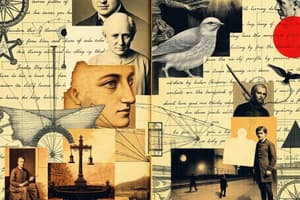Podcast
Questions and Answers
What is the estimated date of the Voynich manuscript based on carbon dating?
What is the estimated date of the Voynich manuscript based on carbon dating?
- 1800
- 1420 (correct)
- 1600
- 1200
Who is the Voynich manuscript named after?
Who is the Voynich manuscript named after?
- A medieval scribe
- A Polish bookseller (correct)
- An Italian priest
- A historical linguist
What is a distinctive feature of the Voynich manuscript's writing?
What is a distinctive feature of the Voynich manuscript's writing?
- It is written in a single, consistent hand
- It uses only vowels
- It features varied letter styles and heights (correct)
- It is written entirely in capital letters
What is one theory about the Voynich manuscript's text?
What is one theory about the Voynich manuscript's text?
What is a possible explanation for the unique characteristics of the Voynich manuscript's script?
What is a possible explanation for the unique characteristics of the Voynich manuscript's script?
What is one speculation about the contents of the Voynich manuscript?
What is one speculation about the contents of the Voynich manuscript?
What is one of the 'gallows characters' in the Voynich manuscript?
What is one of the 'gallows characters' in the Voynich manuscript?
How many hands are believed to have written the Voynich manuscript?
How many hands are believed to have written the Voynich manuscript?
Flashcards are hidden until you start studying
Study Notes
The Voynich Manuscript
- The Voynich manuscript is a 240-page book written on vellum pages with looping handwriting and hand-drawn images, featuring real and imaginary plants, floating castles, bathing women, astrology diagrams, zodiac rings, and suns and moons with faces.
- The manuscript was carbon dated to around 1420.
- The book is 24x16 centimeters in size and is named after Polish bookseller Wilfrid Voynich, who purchased it from a Jesuit college in Italy in 1912.
Unresolved Mysteries
- No one can decipher the text in the Voynich manuscript, despite numerous attempts over the past century.
- The writing has consistent patterns, similar to real languages, but with unique characteristics that defy understanding.
- The manuscript features varied letter styles and heights, with some borrowed from other scripts and others being unique, including the "gallows characters".
- The text appears to be written by two or more hands, with separate artwork done by another party.
Theories about the Manuscript's Text
- Three main theories have emerged: that the text is a cipher, a hoax written in gibberish, or an actual language written in an unknown script.
- The cipher theory suggests the text is a secret code deliberately designed to hide its meaning.
- The hoax theory proposes that the document was written to deceive a buyer, possibly by Voynich himself or a medieval con man.
- The unknown script theory suggests that medieval scholars were attempting to create an alphabet for a spoken language that was not yet written.
Speculations and Breakthroughs
- Some believe the manuscript might be an encyclopedia containing knowledge of the culture that produced it.
- Others believe it was written by notable historical figures such as Roger Bacon or John Dee.
- Fringe theories include the book being written by Italian witches or Martians.
- Recent breakthroughs include carbon dating and tracing the provenance of the manuscript back to 1612, when it was possibly passed from Holy Roman Emperor Rudolf II to his physician, Jacobus Sinapius.
- Linguistic researchers have provisionally identified a few words, including possible references to Taurus and the Centaurea plant.
Implications and Possibilities
- If the code is cracked, the manuscript might reveal the dream journal of a 15th-century illustrator, nonsense, or the lost knowledge of a forgotten culture.
The Voynich Manuscript
- Consists of 240 pages written on vellum with looping handwriting and hand-drawn images
- Features real and imaginary plants, floating castles, bathing women, astrology diagrams, zodiac rings, and suns and moons with faces
- Carbon dated to around 1420
- Size: 24x16 centimeters
- Named after Polish bookseller Wilfrid Voynich, who purchased it in 1912
Unresolved Mysteries
- Text remains undecipherable despite numerous attempts over the past century
- Writing has consistent patterns similar to real languages but with unique characteristics
- Features varied letter styles and heights, including "gallows characters"
- Text appears to be written by two or more hands, with separate artwork done by another party
Theories about the Manuscript's Text
- Three main theories: cipher, hoax written in gibberish, or actual language written in unknown script
- Cipher theory: text is a secret code designed to hide its meaning
- Hoax theory: document was written to deceive a buyer
- Unknown script theory: medieval scholars attempted to create an alphabet for a spoken language
Speculations and Breakthroughs
- Possibly an encyclopedia containing knowledge of the culture that produced it
- Others believe it was written by notable historical figures (e.g., Roger Bacon or John Dee)
- Recent breakthroughs: carbon dating, tracing provenance back to 1612
- Linguistic researchers have provisionally identified a few words (e.g., possible references to Taurus and Centaurea plant)
Implications and Possibilities
- If the code is cracked, the manuscript might reveal the dream journal of a 15th-century illustrator, nonsense, or lost knowledge of a forgotten culture
Studying That Suits You
Use AI to generate personalized quizzes and flashcards to suit your learning preferences.



